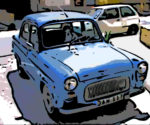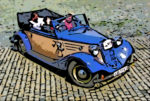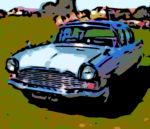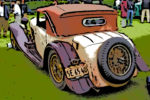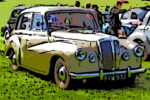If this all feels like a history lesson then that’s because it is.
You can’t just look at two people fighting and understand what’s going on, or who is right or wrong, or why they’re fighting now, without understanding what brought them to the point at which they decided or were impelled to fight. Especially when afterwards they more or less fall into each other’s arms and slowly learn to forgive each other.
Life just doesn’t work that way.
We kids were brought up to believe that violence was wrong: the last refuge of the incompetent. Really? This dictum came from the two adult males in our lives who had attempted to slaughter each other. No wonder we kids were fucked up conflicted and under stress.
I bought my first car at 15 without telling anyone adult in the family, paid cash and somehow convinced the salesman on the used-car lot that I was older. Drove it home uninsured but utterly confident. A Mk 1 Austin A55 “Cambridge” with rotten wings, wheezing manifolds, shot main bearings, a sump full of sawdust to disguise the crankshaft damage, and a column change that subsequently lost its settings every other day. I didn’t know enough to know it was a wreck before I bought it and thought I’d bought a bargain. In those days I even thought second-hand car salesmen trading from open yards were honest. The time and effort I spent attempting to restore it was entirely wasted: even if I’d had the knowledge skills and patience to do the job properly. All I was doing was copying father, who did know.
I first heard about the Jaguar from Jim, who had been part of the rescue effort the night before. Jim ran a small local garage from a set of lockups at the back of our house, which sounds far too grand: the house where we lived in a tiny cold-water walk-up flat in the 5th floor attic eaves: Jim repaired engines, supplied second-hand parts scavenged from terminally dead cars and vans and doing the odd tow job for the local police after accidents: all the local male kids and one or two more adventurous girls would hang around the lockups on weekends vying for “errands” to do in exchange for cups of tea and stale crumbly biscuits and a chance to sit in the driving seat of whatever was in his yard at the time. Jim was a former wartime RMTC mechanic with a love of and infinite patience with anything motorised; he could fix almost anything on wheels or tracks, and regularly did so, keeping vehicles on the road for his customers long after they should by rights have died and gone to their graveyards, all done in a manner found today only in the most rural parts of Africa and India and the foothills of the Himalayas and Andes. It was that shared love and patience which made such strange friends of Jim and my father. The only other things they had in common were a relatively short and burly stature and huge physical strength: they barely spoke the same language given how poor my father’s English could be at times, and how deeply inflected Jim’s “Welsh” English became when excited; except when they were both talking cars or engineering. Then some kind of “engineering” osmosis took place: a few words or gestures were more than sufficient for the most deeply complex subjects to be shared and understood.
The Jaguar was an accident recovery. One wintry Friday night in 1956 a drunken idiot missed the turn onto the bridge at Avenue Road leading to Regent’s Park’s Outer Circle, skidded badly on black ice, and punted the car through the railings, down the embankment, and halfway into the Regent’s Canal. Jim was called out early next morning to recover the car and for some reason he asked father to go along to assist. Sometime during that cold wet Saturday morning, as they were pulling the car up the canal embankment, father somehow discovered that the owner had no interest in having his car back and conceived a notion to have it himself – mainly I suspect because its style and form reminded him greatly of the Alfa 8C he claimed to have driven with such glee before the war.
By the time they got the car back to Jim’s lockups father had made the deal: he would pay Jim some of the money towards the recovery and the owner would take £5 for the car’s papers. On paper a superb deal for any car at all, in the days when a small family car cost £300 new, second-hand cars were still relatively rare [and often quite a dodgy proposition] and a family counted itself very lucky to have a weekly income of more than £75.
So, before lunch on Sunday morning, we were dragged downstairs to Jim’s yard to view this car that would soon replace our aging Ford Poplar.
It was a 1950 Jaguar Mk V 3.5 litre three-position two-door drophead coupe in cream with a burgundy overstripe and an interior that was all leather, wood and woollen carpeting. The front end had suffered badly from the impact with the embankment railings and, although I didn’t know it at the time, both axles had suffered as well. The front from crashing over the embankment’s lower curbing and smashing down to bury its nose in the canal, the rear from the stresses of towing the car free of its near-watery grave and up the Regents Canal embankment. Fortunately the chassis was undamaged, although much of the front passenger area and the engine bay was badly waterlogged and filthy with oil and other debris.
None the less within four months father had dried everything out, refinished the solid timber dashboard and cabin fittings after their soaking, stripped and rebuilt the engine and then recommissioned the entire car. An heroic effort. We took our first trip in it as a family on May Day of 1956, a trip out to Hainault in Essex to visit Viktor and his wife, and then take them for a picnic in Epping Forest. After the cramped confines of the Poplar it was a comfortably luxurious and fun journey around the North Circular in the late spring sunshine with the top down. We kids, untrammeled by seat belts, lounged around the back seat and played I-Spy whilst father reveled in the comfort and power of his new toy, having almost recaptured a sense of his life before the war. We felt posh!
Looking back now I realise just how much work father must have done in one of Jim’s spare lockups to get the car on the road; repairs to the bodywork
and interior would have been child’s play to him, as would the engine rebuild, but the damage to the axles and their springs and chassis mounts would almost certainly have been more serious and probably required costly parts which were not easily available: I suspect, but don’t know for sure, that he repaired wherever possible, rather than buying replacement parts – and did deals with Jim to secure parts via the RMTC old-boys network: that was much more his way of working.
He had the skills to hand-make engine components and machine other complex parts from raw metal billet if required. It’s a set of skills I tried many times to emulate in the early part of my life, whilst repairing or restoring my own cars; each time with bad and sometimes expensive results; eventually in my late twenties the time came for me to accept that I had neither his skills or patience and needed to stop trying to get his approval that way. Something that would have been very difficult since he’d been dead since the autumn of 1961, shortly after part-exchanging the utterly memorable and beautiful Jaguar for an offensively brand-new and utterly tawdry two-tone white over blue Vauxhall Cresta PA.
No class, no character and nothing whatever to commend it, other than the fact that it started moved and stopped in a technically correct manner . Sadly the Jaguar was punted onwards by the Vauxhall dealer to an owner who knew nothing of the car and its history and value and cared even less; it was just cheap transport. Over the next few years it gradually decayed and became a mobile and notoriously recognisable eyesore around north London.
In the mid 1970’s, more than a decade after father sold it, I saw the Jaguar in the window of Hexagon in Highgate, fully restored and for sale at a cool £17,000. An enormous price for those days before classic cars had begun to make a real market for themselves. Somebody who knew what they were doing had done a good job, once again bringing that car back to life. I hope whoever bought it enjoyed it.
Father loved his cars and the intricacies of their engineering, he loved good design, and kept his cars in perfect condition, which is why when he made that particular swap it was a total mystery to me. I don’t think I really forgave him that, and I certainly never had a chance to discuss it with him. The only reason I can now think of was that he knew he was extremely ill and mother had recently passed her driving test and he therefore wanted a car which she would find relatively easy to drive, something the Jaguar patently was not, requiring muscular strength and some dexterity with the Moss crash gearbox and a rather heavy clutch pedal if one was going to wrestle it around the tiny streets and tight corners of the hilltop villages of north London. The Jaguar was most at home on the open and relatively empty major roads of the late 50s and 60s where it filled its role as a luxurious and comfortable tourer. It was not and never really could be a city runabout.
Between the wars father had driven a great variety of vehicles, from the prosaic and basic open delivery vans the firm owned, through humble middle range family saloons to his own personal swish and very expensive custom-bodied Alfa 8C coupe. The Alfa was his fun car, for rallying and racing at high speed across the country, or for business trips abroad to visit customers in Germany Austria and Italy.
Shortly after we moved to Belsize Park in London, being utterly broke at the time, he felt starved of the road, of movement, and lost without cars, until an elderly and somewhat prosperous but war-wounded neighbour with badly damaged legs, and also a friend and customer of Jim’s garage, asked if father would mind driving him around to shops and parks and museums and so forth from time to time, in exchange for use of the car when it wasn’t needed. At the age of 7 I was given my first drives in that proud old Daimler Conquest, with its wonderful smell of rich leather and timber and it’s wire-spoked steering wheel and old-fashioned Wilson pre-selector box. Sitting on father’s lap I was allowed to steer the car around the yard, and up and down the rutted lane beside the house to Jim’s garages. My feet couldn’t reach the pedals, but father insisted he would only operate them when I told him to; he took this seriously and if I forgot to tell him to brake or change gear he would behave appropriately and we’d gently bump the wall at the end of our journey. I soon learned to think ahead and tell him what needed to be done; it’s a lesson I’ve never forgotten.
When Emanuel came over from Darmstadt to visit us in Highgate, on his way to Brown’s Lane, in the summer of 1961 to place a personal order for his new E Type Jaguar he was astonished to discover that father had disposed of the Mk V, whilst I was equally astonished that Emanuel wasn’t buying a Porsche 365, and said so, given that the Porsche was home-made “why buy a British sports car when there’s such a good German sports car?” The near-identical non-consultative and simultaneous response from both Emanuel and my father was enlightening: “Wouldn’t buy one if you paid me; the man’s a thief, that was Ledwinka’s design concept!” and Emanuel added with a smile “the Jaguar is prettier and faster.” He was right, Malcolm Sayer’s original design still looks brilliant today.
It was that sympathy and understanding over matters of intellectual and design integrity and form and quality – understandings which they also shared with respect to music art and photography – that made them good friends, despite father’s understandably strong feelings about Germany and Germans. In many ways father and Emanuel had far more in common than father ever did with his own surviving brother, with whom all conversation and interaction was still too competitive. It was sad that he and Emanuel had only those few short years in which to know each other: they both died far too early. Although father never entirely reconciled himself to Germany after the war he was, by that point, once more willing to accept that there were good Germans; had he and Emanuel each lived another decade they would, I think, have brought about that reconciliation.
Some years later I was lucky enough to meet Sayer’s children, at their family home in north London, and had a sadly all too brief chance to examine some of his original drawings; he was a meticulous draughtsman with a great eye for detail. His first ‘cartoon’ drafts of the E type design which I saw were cleaner and more elegant than the production vehicle, perhaps because he had anticipated technology; double and triple curvature triplex glass was still almost impossibly expensive and very complex to fabricate at that time, so the production car went out with what is in essence a single curvature deeply wrapped screen, which required additional metal in the somewhat more upright A posts than he had originally designed or wished for. Ironically those production compromises clearly aided both aerodynamics and structural integrity. The amusing irony for me of that insight was that at the time when father had his Jaguar on the road, and Sayer was working on the E Type design, father was working at Triplex in Hounslow, trying to implement the very same double and triple axis curvatures for plexiglass and other laminated safety glasses which Sayer so badly wanted for the E type. I can’t help wondering what might have happened if Sayer and my father had met. Such a meeting might not have done the E Type any favours.
In the years that followed, after father had died, Emanuel drove his E Type all over Europe, blasting down the rapidly expanding network of high speed roads to visit music festivals or business colleagues and took great pleasure in overtaking any Porsche he encountered. His favourite drive, from Darmstadt down into Italy via the old Brenner Pass often proved a great test of skill in those days before the modern motorway was constructed.

